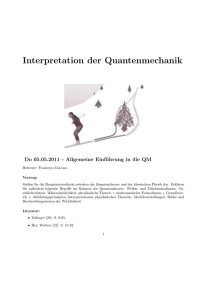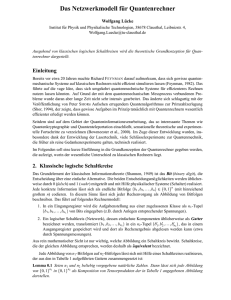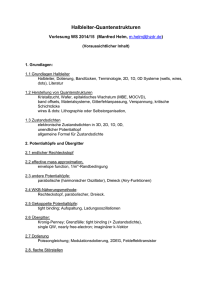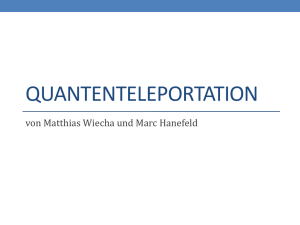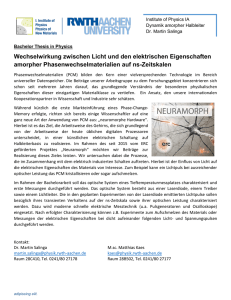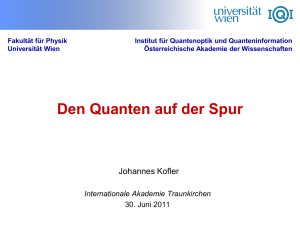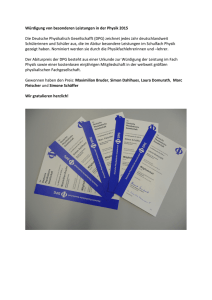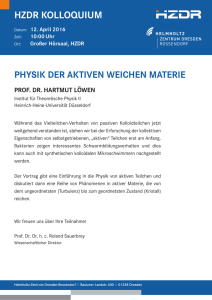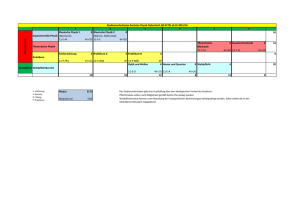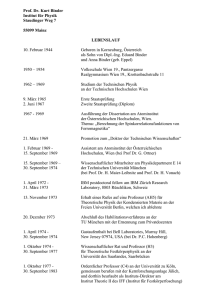Peter Mittelstaedt 1929–2014 - User Web Areas at the
Werbung
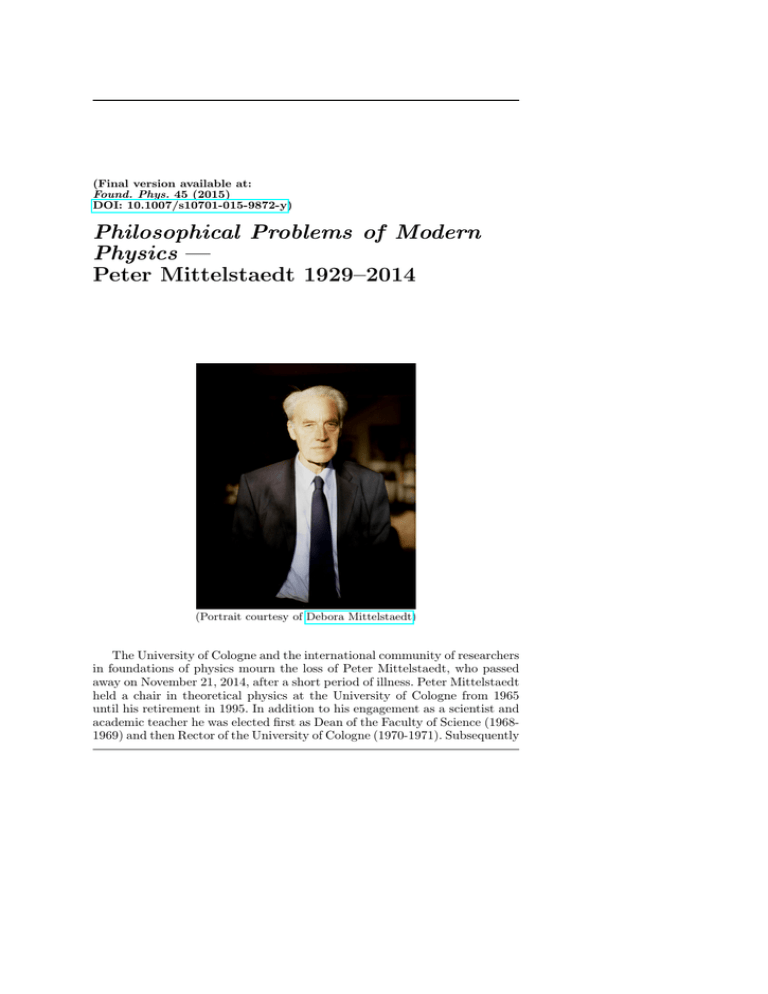
(Final version available at: Found. Phys. 45 (2015) DOI: 10.1007/s10701-015-9872-y) Philosophical Problems of Modern Physics — Peter Mittelstaedt 1929–2014 (Portrait courtesy of Debora Mittelstaedt) The University of Cologne and the international community of researchers in foundations of physics mourn the loss of Peter Mittelstaedt, who passed away on November 21, 2014, after a short period of illness. Peter Mittelstaedt held a chair in theoretical physics at the University of Cologne from 1965 until his retirement in 1995. In addition to his engagement as a scientist and academic teacher he was elected first as Dean of the Faculty of Science (19681969) and then Rector of the University of Cologne (1970-1971). Subsequently 2 he served as Prorector (1971-1973) and Prorector for Research (1991-1994). He was an elected member of l’Académie Internationale de Philosophie des Sciences and founding member and president of the International Quantum Structures Association (1994-1996). Peter Mittelstaedt was born in Leipzig on November 24, 1929. In his childhood home he may already have witnessed the spirit of philosophical discourse about the world-picture of modern physics. For Werner Heisenberg, one of the architects of the then new theory of quantum mechanics, was a regular participant at the Mittelstaedt family’s musical evenings. Following his studies of physics at the universities of Jena, Bonn and Göttingen, Peter Mittelstaedt obtained his doctorate in theoretical physics under Werner Heisenberg in 1956. He spent his postdoctoral years at CERN (Geneva), MIT (Cambridge, Mass.) and the Max Planck Institute for Physics and Astrophysics, establishing himself with a series of publications on problems of theoretical nuclear physics. In 1961 he obtained the Habilitation in theoretical physics at the University of Munich and continued to teach there as a Privatdozent until 1965 when he accepted a chair in theoretical physics at the University of Cologne. It was already during this time at Munich that philosophical problems became an integral part of his research agenda. In Cologne, Mittelstaedt put the foundations and philosophical significance of the fundamental theories of modern physics—relativity and quantum mechanics—at the centre of an extensive research programme comprising physical, philosophical and logical investigations. He undertook penetrating studies of the limits of validity of classical physical theories and the boundaries between these theories and their modern successors. Philosophical problems raised by quantum mechanics – problems concerning causality, objectivity, reality, and locality – remained core themes in Peter Mittelstaedt’s work where they are analyzed in his characteristic lucid style. He gave insightful discussions of questions such as whether there is objective chance in Nature, or whether all interactions are local, and whether the world can be described by a universal and self-consistent theory. A detailed review and appraisal of Peter Mittelstaedt’s life work as a theoretical physicist and philosopher of science was given in a special issue of Foundations of Physics in 2010 on the occasion of his 80th birthday [1, 2, 3, 4]. His 50th and 60th birthdays were celebrated with a Festschrift volume of contributions from colleagues and friends in 1979 [5] and a sequence of three dedicated issues in Foundations of Physics in 1989, respectively [6]. The complete authorized list of publications is available at a dedicated homepage [7], and the University of Cologne website holds Peter Mittelstaedt’s curriculum vitae (in German) in a section dedicated to its former Rectors [8]. In addition to more than 100 publications in scientific journals, Mittelstaedt wrote a number of widely noted books and monographs including Philosophical Problems of Modern Physics (German original 1963, 7th ed. 1989; translated into English and several other languages), Classical Mechanics (in German, 1970, 2nd ed. 1995), The Concept of Time in Physics (in German, 1976, 3rd ed. 1989), Quantum Logic (1978), Language and Reality in Modern Physics (in German, 1986), The Quantum Theory of Measurement (with P. Busch and P. Lahti 1991, 2nd rev. ed. 1996), The Interpretation 3 of Quantum Mechanics and the Measurement Process (1998), and Laws of Nature (with P. Weingartner 2005). Peter Mittelstaedt’s influence as an academic and scholar was rooted in no small measure in the exceptional quality of his lectures and presentations, which established his international reputation as a brilliant and inspiring speaker. This is documented in a long list of plenary talks and public lectures, including the academic key address he was invited to give on the occasion of the 600th anniversary of the University of Cologne in 1988. Mittelstaedt was an exemplary academic teacher and mentor who enjoyed high esteem and affection from his students and collaborators. He was a fond advocate of the Socratic method of maieutics, which he practised in scientific conversations and oral examinations alike. Through the 30 years of his tenure at the University of Cologne, he supervised 30 doctoral dissertations, and seven of his students moved into academic and research careers. In the 1980s and 1990s, the Cologne school of foundations of physics became a centre of gravity for numerous junior scientists who joined the Mittelstaedt group as Alexander von Humboldt fellows. Peter Mittelstaedt’s last book, Rational Reconstructions of Modern Physics (2011, 2nd extended ed. 2013), has now become his scientific legacy. It constitutes a systematic exposition of his philosophical ansatz for a foundation and understanding of the theories of relativity and quantum mechanics. In a lucid argument, certain ontological premises underlying classical physics are exposed as lacking justification, and indeed found untenable in the light of empirical evidence that became available in the early 20th Century. Once these premises are removed, the seemingly counterintuitive structures of the modern physical theories are seen to emerge naturally. Colleagues and scientific friends of Peter Mittelstaedt will consider it a special gift that he was allowed to complete this unique synthesis and synopsis of his philosophical life work. We will gratefully remember him as a human being of aristocratic stature endowed with an eminent and yet gentle and amiable personal presence. Paul Busch (University of York, York, UK) Literatur 1. P. Busch: Between Physics and Philosophy – Festschrift for Peter Mittelstaedt on his 80th Birthday, Found. Phys. 40 (2010) 1161. 2. P. Busch, J. Pfarr, M. Ristig and E.-W. Stachow: Quantum–Matter–Spacetime: Peter Mittelstaedt’s Contributions to Physics and its Foundations, Found. Phys. 40 (2010) 1163. 3. B. Falkenburg: Language and Reality – Peter Mittelstaedts Contributions to the Philosophy of Physics, Found. Phys. 40 (2010) 1171. 4. Peter Mittelstaedt: List of Publications until 2010, Found. Phys. 40 (2010) 1189. 5. J. Nitsch, J. Pfarr and E.-W. Stachow (eds.): Grundlagenprobleme der Modernen Physik (Bibliographisches Institut Mannheim, 1981). 6. P. Busch and A. van der Merwe: Peter Mittelstaedt – Philosopher-Physicist, Found. Phys. 19 (1989) 789. 7. www.peter-mittelstaedt.de 8. rektorenportraits.uni-koeln.de/rektoren/peter mittelstaedt. 4 Peter Mittelstaedt: List of Publications 1954–2014 This bibliography has been compiled using the list of publications on a webpage dedicated to Peter Mittelstaedt and maintained by Helmut Fink (Erlangen) at the URL www.peter-mittelstaedt.de. While originally established in close consultation with Peter Mittelstaedt, the list is unlikely to be complete and contains a few items that were added posthumously. 1 Books 1.1 Monographs 1. Philosophische Probleme der Modernen Physik. BI-Wissenschaftsverlag, Mannheim, 1st. ed. 1963, 7th ed. 1989. 2. Klassische Mechanik. BI-Wissenschaftsverlag, Mannheim, 1st ed. 1970, 318 pp., 2nd ed. 1995. 3. Die Sprache der Physik, Aufsätze und Vorträge. BI-Wissenschaftsverlag, Mannheim 1972. 4. Philosphical Problems of Modern Physics. English translation of [1], 4th ed. 1972, D. Reidel Publ. Co., Dordrecht, Holland, 1975. 5. Der Zeitbegriff in der Physik. BI-Wissenschaftsverlag, Mannheim, 1976, 164 pp., 3rd ed. 1989. 6. Quantum Logic. D. Reidel Publ. Co. Dordrecht, Holland, 1978. 7. Sprache und Realität in der modernen Physik. BI-Wissenschaftsverlag Mannheim, 1986. 8. The Quantum Theory of Measurement (with P. Busch and P. Lahti). Lecture Notes in Physics m2, Springer, Berlin, 1991, Second revised edition, 1996. 9. The Interpretation of Quantum Mechanics and the Measurement Process, Cambridge University Press, Cambridge, UK, 1998. 10. Laws of Nature (with P. Weingartner), Springer Verlag, Heidelberg, 2005. 11. Rational Reconstructions of Modern Physics, Springer Verlag, Heidelberg, 2011, 2nd. ed. 2013. 1.2 Conference Proceedings 1. Symposium on Quantum Logic. Special Issue, Journal of Philosophical Logic, 1977. 2. Grundlagen der Quantentheorie. (With J. Pfarr). BI-Wissenschaftsverlag, Mannheim, 1980. 3. Recent Developments in Quantum Logic. (With E.-W. Stachow). BI-Wissenschaftsverlag, Mannheim, 1985. 4. Symposium on the Foundations of Modern Physics: 50 years of the EinsteinPodolsky-Rosen Gedankenexperiment. (With P. Lahti). World Scientific, Singapore, 1985. 5. Symposium on the Foundations of Modern Physics 1987. The Copenhagen Interpretation 60 years after the Como lecture. (With P. Lahti). World Scientific, Singapore, 1987. 6. Symposium on the Foundations of Modern Physics 1990. Quantum theory of measurement and related philosophical problems. (With P. Lahti). World Scientific, Singapore, 1991. 7. Symposium on the Foundations of Modern Physics 1993. Quantum measurement, irreversibility and the physics of information. (With P. Busch and P. Lahti). World Scientific, Singapore, 1993. 5 8. Ethik und Wissenschaftlicher Fortschritt. Bouvier-Verlag Bonn, 1995. 9. Workshop on Superluminal(?) Velocities. (With G. Nimtz), Special Issue, Annalen der Physik (Leipzig) 7 (1998). 10. Was sind und warum gelten Naturgesetze? (With G. Vollmer), Special Issue, Philosophia Naturalis 37, Heft 2 (2000). 2 Scientific papers 2.1 Nuclear Physics and Quantum Many-Body Theory 1. Nichtlineare Mesontheorie und Absättigung der Kernkräfte, Z. Physik 137 (1954), 545-571. 2. Zur Verteilung der Protonen in schweren Atomkernen, Z. Naturforsch. 10a (1955), 379-383. 3. Die Verteilung der Nucleonen in schweren Atomkernen, Fortschr. Physik III (1955), 497-535. 4. Zur theoretischen Bestimmung der Neutronenreaktionsquerschnitte nach dem optischen Kernmodell, Z. Naturforsch. 11a (1956), 663-676. 5. Über ein optisches Kernmodell für Neutronenreaktionsquerschnitte, Z. Naturforsch. 12a (1957), 643-646. 6. Zur Begründung des optischen Kernmodells, Z. Naturforsch. 12a (1957), 675-678. 7. Optisches Modell für die Streuung von K-Mesonen an Kernen, Z. Naturforsch. 12a (1957), 947-955. 8. Zur Energieverteilung der inelastischen Streuung von K-Mesonen an Kernen, Nuovo Cim. X (1957), 1480-1496. 9. Zur Streuung von K-Mesonen an komplexen Kernen, Nucl. Phys. 6 (1958), 50-54. 10. Zur phänomenologischen Theorie der Kernmaterie, Nucl. Phys. 8 (1958), 171-190. 11. Phenomenological Theory of Nuclear Matter, C. I. P. N. - Communic., Paris (1958), 772-775. 12. On the Rearrangement Energy of Nuclear Matter, Nucl. Phys. 9 (1958/59), 116-123. 13. On the Problem of Rearrangement Energy of Nuclear Matter, Nucl. Phys. 17 (1960), 499-515. 14. On the Degeneracy of the Superconductive State, Nucl. Phys. 25 (1961), 522-528. 15. Über die Entartung des Grundzustandes in der Theorie der Supraleitung, in: F. Bopp (ed.), Werner Heisenberg und die Physik unserer Zeit, Vieweg Verlag, Braunschweig (1961), pp. 195-206. 16. On the Moment of Inertia in Large Nuclear Systems with Pairing Forces, Z. Physik 168 (1962), 6-9. 17. On the Density Fluctuations of the Superconducting State, Z. Physik 167 (1962), 439-445. 18. Single Particle Energies of Nuclear Matter and the Reference Spectrum Method, Z. Physik 175 (1963), 184-199. 19. The Method of Effective Interaction in Nuclear Physics, Hung. Phys. Acta., Tom. XIX (1965), 303-314. 20. Equivalent Nonlocal Nucleon-Nucleon Potentials (with M. Ristig), Z. Physik 193 (1966), 343-357. 21. The Equation of State of Neutron Matter (with S. Kistler and W. Weyer), Z. Physik 234 (1970), 479-492. 6 2.2 Relativity and Cosmology 1. Das Uhrenparadoxon, Sterne und Weltraum 8/9 (1964), 191-194. 2. On the Geometrical Interpretation of the Theory of Gravitation in Flat Space (with J.B. Barbour), Z. Physik 203 (1967), 82-90. 3. Kosmologische Lösungen der lorentzinvarianten Gravitationstheorie, Z. Physik 211 (1968), 271-292. 4. Physikalische Gesetze in beschleunigten Bezugssystemen (with H. Heintzmann), Springer Tracts in Modern Physics 47 (1968), 187-225. 5. Lorentzinvariante Gravitationstheorie, in: Arbeitsgemeinschaft für Forschung des Landes Nordrhein-Westfalen, Heft 202, Westdeutscher Verlag, Köln und Opladen (1970), pp. 1-20. 6. Conventionalism in Special Relativity, Found. Phys. 7 (1977), 573-583. 7. Der Dualismus von Feld und Materie in der Allgemeinen Relativitätstheorie, Einstein-Symposium Berlin, Lecture Notes in Physics 100, Springer-Verlag, Berlin (1979), pp. 309-319. 8. Protophysik und spezielle Relativitätstheorie, in: K. Lorenz (ed.), Konstruktionen versus Positionen, Vol. I, Walter de Gruyter, Berlin (1979), pp. 290310. 9. Über die Bedeutung und Begründung der speziellen Relativitätstheorie, in: J. Audretsch and K. Mainzer (eds.), Philosophie und Physik der Raum-Zeit, BI-Wissenschaftsverlag, Mannheim (1988), pp. 83-102. 10. A Simple Experimental Demonstration of the Principle of Equivalence (with W. Klein), Am. J. Phys. 65 (1997), 316-320. 11. What if there are Superluminal Signals?, Eur. Phys. J. B 13 (2000), 353-355. 2.3 Quantum Logic 1. Untersuchungen zur Quantenlogik, Ber. Bayer. Akad. Wiss. (1959), pp. 321386. 2. Über die Gültigkeit der Logik in der Natur, Naturwiss. 47 (1960), pp. 385391. 3. Quantenlogik, Fortschr. Physik 9 (1961), 106-147. 4. Logik und Quantenlogik, Physikalische Blätter 1 (1962), 23-29. 5. Quantenlogische Interpretation orthokomplementärer, quasimodularer Verbände, Z. Naturforsch. 25a (1970), 1773-1778. 6. Objektivierbarkeit, Quantenlogik und Wahrscheinlichkeit, in: E. Scheibe and G. Süßmann (eds.), Einheit und Vielheit, Festschrift für C. F. von Weizsäcker, Vandenhoeck und Ruprecht, Göttingen (1972), pp. 119-139. 7. On the Interpretation of the Lattice of Subspaces of the Hilbert Space as a Propositional Calculus, Z. Naturforsch. 27 (1972), 1358-1362. 8. Operational Foundation of Quantum Logic (with E.-W. Stachow), Found. Phys. 4 (1974), 355-365. 9. Quantum Logic, in: Proceedings of the Fourth Biennal Meeting of the Philosophy of Science Association, University of Notre Dame, 1974, Boston Studies in the Philosophy of Science, Vol. XXXII, D. Reidel Publishing Co., Dordrecht (1976), pp. 501-514. 10. Time Dependent Propositions and Quantum Logic, J. Phil. Logic 6 (1977), 463-472. 11. Quantum Logic, in: Problems on the Foundations of Physics, Proceedings of the International School of Physics “Enrico Fermi”1977, North Holland Publishing Co., Amsterdam (1979), pp. 264-299. 12. The Principle of Excluded Middle in Quantum Logic, J. Phil. Logic 7 (1978), 181-208. 13. Objektivierbarkeit, Quantenlogik und Wahrscheinlichkeit, in Alexander von Humboldt-Tagung, Kyoto 1978, Bonn (1979), pp. 327-336. 7 14. The Metalogic of Quantum Logic, in: P.D. Asquith and I. Hacking (eds.), PSA 1978, Philosophy of Science Association, East Lansing, Michigan (1978), pp. 249-256. 15. The Modal Logic of Quantum Logic, J. Phil. Logic 8 (1979), 479-504. 16. Modalities in Quantum Logic, in: Abstracts of the 6th International Congress of Logic, Methodology, and Philosophy of Science, Bönecke Druck, Clausthal (1979), pp. 112-116. 17. Die Metalogik der Quantenlogik, in: P. Mittelstaedt and J. Pfarr (eds.), Grundlagen der Quantentheorie, Bibliographisches Institut, Mannheim (1980), pp. 59-71. 18. The Concepts of Truth, Possibility, and Probability in the Language of Quantum Physics, in: H. Neumann (ed.), Interpretations and Foundations of Quantum Theory, Bibliographisches Institut, Mannheim (1981), pp. 70-94. 19. Classification of Different Areas of Work Afferent to Quantum Logic, in: E. Beltrametti and B.C. van Fraassen (eds.), Current Issues in Quantum Logic, Plenum Publ. Co., New York (1981), pp. 3-16. 20. The Dialogic Approach to Modalities in the Language of Quantum Physics, in: E. Beltrametti and B.C. van Fraassen (eds.), Current Issues in Quantum Logic, Plenum Publ. Co., New York (1981), pp. 259-281. 21. Relativistic Quantum Logic, Int. J. Theor. Phys. 22 (1983), 293-314. 22. Analysis of the Einstein-Podolsky-Rosen Experiment by Relativistic Quantum Logic (with E.-W. Stachow), Int. J. Theor. Phys. 22 (1983), 517-540. 23. Quantum Logic and Relativistic Space-Time, in: L. Castell and C.F. von Weizsäcker (eds.), Quantum Theory and the Structure of Time and Space, C. Hanser Verlag, München (1983), 54-81. 24. Naming and Identity in Quantum Logic, in: Abstracts of the 7th International Congress of Logic, Methodology and Philosophy of Science, Vol. 4, Salzburg (1983), pp. 138-141. 25. Analysis of the EPR-Experiment by Relativistic Quantum Logic, in: Proc. Int. Symp. Foundations of Quantum Mechanics, Tokyo 1983, pp. 251-255. 26. Constituting, Naming, and Identity in Quantum Logic, in: P. Mittelstaedt and E.-W. Stachow (eds.), Recent Developments in Quantum Logic, BIWissenschaftsverlag, Mannheim (1985), pp. 215-234. 27. EPR-Paradox, Quantum Logic, and Relativity, in: P. Lahti and P. Mittelstaedt (eds.), Symposium on the Foundations of Modern Physics 1985, World Scientific, Singapore (1985), pp. 171-186. 28. Naming and Identity in Quantum Logic, in: P. Weingartner and G. Dorn (eds.), Foundations of Physics, Vienna (1986), pp. 139-161. 29. Quantum Logical Analysis of Delayed-Choice Experiments, in: Proc. 2nd Int. Symp. Foundations of Quantum Mechanics, Tokyo 1987, pp. 53-58. 30. The Leibniz Principle in Quantum Logic (with R. Giuntini), Int. J. Theor. Phys. 28 (1989), 159-168. 2.4 Foundations of Quantum Mechanics 1. Über das Einstein-Podolsky-Rosen Paradoxon, Z. Naturforsch. 29a (1974), 539-548. 2. Unsharp Particle-Wave Duality in a Photon Split-Beam Experiment (with A. Prieur and R. Schieder), Found. Phys. 17 (1987), 891-903. 3. Language and Reality in Quantum Physics, in: P. Lahti and P. Mittelstaedt (eds.), Symposium on the Foundations of Modern Physics 1987, World Scientific, Singapore (1987), pp. 229-250. 4. Simultaneous Unsharp Measurements of Complementary Observables in a Double Slit Experiment, in: Proceedings of the 3rd International Symposium on the Foundations of Quantum Mechanics, Tokyo (1989), pp. 153-160. 5. Objektivität und Realität in der Quantenphysik, in: J. Audretsch and K. Mainzer (eds.), Wieviele Leben hat Schrödingers Katze?, BI-Wissenschaftsverlag, Mannheim (1990), pp. 125-155. 8 6. The Objectification in the Measuring Process and the Many Worlds Interpretation, in: P. Lahti and P. Mittelstaedt (eds.), Symposium on the Foundations of Modern Physics 1990, World Scientific, Singapore (1991), pp. 261-297. 7. Chirality as a Quasi-Classical Property of Molecular Systems (with B. Fischer), Phys. Lett. A 147 (1990), 411-416. 8. An Inconsistency between Quantum Mechanics and its Interpretation: The Disaster of Objectification, in: Advances in Scientific Philosophy, Poznan Studies in the Philosophy of Science and Humanities 24 (1991), 203-214. 9. The Problem of Objectification in Quantum Mechanics (with P. Busch), Found. Phys. 21 (1991), 889-904. 10. Some Important Classes of Quantum Measurements and their Information Gain (with P. Busch and P. Lahti), J. Math. Phys. 32 (1991), 2270-2775. 11. Unsharp Particle-Wave Duality in Double-Slit Experiments, in: F. Selleri (ed.), Wave-Particle Duality, Plenum Press, New York (1992), pp. 169-186. 12. Weak Objectification, Joint Probabilities and Bell Inequalities in Quantum Mechanics (with P. Busch and P. Lahti), Found. Phys. 22 (1992), 949-962. 13. Testing Quantum Mechanics against a Full Set of Bell Inequalities (with P. Busch, P. Kienzler and P. Lahti), Phys. Rev. A 47 (1993), 4627-4631. 14. Das Problem der Objektivierung in der Quantenmechanik, in: B. Geyer, H. Herwig and H. Rechenberg (eds.), Werner Heisenberg, Physiker und Philosoph, Spektrum Verlag, Heidelberg (1993), pp. 238-243. 15. The Problem of Objectification in Quantum Mechanics and the Ignorance Interpretation, in: H.D. Doebner, W. Scherer and F.E. Schroeck, Jr. (eds.), Proceedings of the 2nd International Wigner Symposium, Goslar 1991, World Scientific, Singapore (1993), pp. 200-204. 16. Quantum Measurements I. The Measuring Process and the Interpretation of Quantum Mechanics, Int. J. Theor. Phys. 32 (1993), 1763-1775. 17. Measurement Induced Interrelations between Quantum Theory and its Interpretation, in: P. Busch, P. Lahti and P. Mittelstaedt (eds.), Symposium on the Foundations of Modern Physics 1993, World Scientific, Singapore (1993), pp. 269-280. 18. Zur Quantentheorie der Messung (with P. Busch), in: K. Mainzer and W. Schirmacher (eds.), Quanten, Chaos und Dämonen, BI-Wissenschaftsverlag, Mannheim (1994), pp. 107-130. 19. Constitution of Objects in Classical Mechanics and in Quantum Mechanics, Int. J. Theor. Phys. 34 (1995), 1615-1626. 20. Is Quantum Mechanics a Probabilistic Theory?, in: R. S. Cohen, M. Horne and J. J. Stachel (Eds.), Potentiality, Entanglement and Passion-at-aDistance, Kluwer Academic Publishers, Dordrecht (1997), pp. 159-175. 21. The Emergence of Statistical Laws in Quantum Physics, in: M. Ferrero and A. van der Merwe (eds.), New Developments on Fundamental Problems in Quantum Physics, Kluwer Academic Publishers, Dordrecht (1997), pp. 265274. 22. Individual Objects, Kinds, and the Identity of Indiscernibles in Physics, in: R. Pratesi and L. Ronchi (eds.), Conference Proceedings Vol. 60, Waves, Information and Foundations of Physics, Società Italiana di Fisica, Bologna (1998), pp. 239-259. 23. Can EPR-Correlations be Used for the Transmission of Superluminal Signals?, Ann. Physik (Leipzig) 7 (1998), 710-715. 24. Individualistic versus Statistical Interpretation of Quantum Mechanics, in: M.L. Dalla Chiara, R. Giuntini and F. Laudisa (eds.), Language, Quantum, Music, Kluwer Academic Publishers, Dordrecht (1999), pp. 231-239. 25. Universell und inkonsistent? - Quantenmechanik am Ende des 20. Jahrhunderts, Physikalische Blätter 56 (2000), Nr. 12, 65-68. 26. Leibniz’s Principle, Physics, and the Language of Physics (with E. Castellani), Found. Phys. 30 (2000), 1587-1604. 27. The Problem of Decoherence and the EPR-Paradox, in: Ph. Blanchard et al. (eds.), Decoherence: Theoretical, Experimental and Conceptual Problems, Lecture Notes in Physics Vol. 538, Springer, Berlin (2000), pp. 149-159. 9 28. Quantum Mechanics without Probabilities, in: M. Rédei and M. Stöltzner (eds.), John von Neumann and the Foundation of Quantum Physics, Kluwer Academic Publishers, Dordrecht (2001), pp. 189-200. 29. Quantum Logic and the Problem of Decoherence, in: T. Gonis and P. Turchi (eds.), Decoherence and its Implications in Quantum Computation and Information Transfer, IOS Press, Amsterdam (2001), pp. 121-136. 30. Interpreting Quantum Mechanics - in the Light of Quantum Logic, in: L. Castell and O. Ischebeck (eds.), Time, Quantum, Information, Springer, Berlin (2003), pp. 281-290. 31. Quantum Logic and Decoherence, Int. J. Theor. Phys. 43 (2004), 1343-1354. 32. Quantum Physics and Classical Physics - in the Light of Quantum Logic, Int. J. Theor. Phys. 44 (2005), 771-781. See also: quant-ph/0211021. 33. Quantum Logic versus Alternative Approaches, Physics and Philosophy, Open Access Online Journal (2007), http://hdl.handle.net/2003/24420, pp. 1-6. 34. Planck’s Constant in the Light of Quantum Logic, Int. J. Theor. Phys. 47 (2008), 104-113. 35. Quantum Holism, Superluminality, and Einstein Causality, Physics and Philosophy, Open Access Online Journal (2008), http://hdl.handle.net/ 2003/25801, pp. 1-15. 36. The Constitution of Objects in Classical Physics and in Quantum Physics, in: M. Bitbol et al. (eds.), Constituting Objectivity, Springer, Berlin (2009), pp. 169-181. 37. Cognition versus Constitution of Objects: From Kant to Modern Physics, Found. Phys. 39 (2009), 847-859. 2.5 Philosophy of Physics, Philosophy of Science 1. Der Begriff der Natur in der modernen Physik, in: Natur und Geist (1964), Klostermann, Frankfurt, pp. 52-62. 2. Verborgene Parameter und beobachtbare Größen in physikalischen Theorien, Philosophia Naturalis X (1968), 468-482. 3. Der Theorienpluralismus in der Physik, in: A. Diemer (ed.), Der Methoden- und Theorienpluralismus in den Wissenschaften, Verlag Anton Hain, Meisenheim am Glan (1971), pp. 185-191. 4. Naturwissenschaft und Gesellschaft, Kölner Universitätsreden 43, Scherpe, Krefeld (1971), pp. 1-19. 5. Die Sprache der Physik, in: H. P. Dürr (ed.), Quanten und Felder, Festschrift für Werner Heisenberg, Vieweg-Verlag, Braunschweig (1971), pp. 27-49. 6. Gibt es eine Geschichte der Physik?, Die wissenschaftliche Redaktion 7, Bibliographisches Institut, Mannheim (1972), pp. 40-48. 7. Der Wissenschaftsbegriff in der Physik, in: F. Rapp (ed.), Der Wissenschaftsbegriff der Natur- und Geisteswissenschaften, Symposium der LeibnizGesellschaft, Hannover, Franz Steiner Verlag, Wiesbaden (1975), pp. 38-49. 8. Erfahrung und Erkenntnis a-priori in der Physik, in: R. Haller (ed.), Philosophie und Physik, Vieweg Verlag, Braunschweig (1975), pp. 7-14. 9. Zur Protophysik der klassischen Mechanik, in: G. Böhme (ed.), Protophysik, Suhrkamp-Verlag, Frankfurt (1976), pp. 131-168. 10. On the Applicability of the Probability Concept in Quantum Mechanics, in: C. A. Hooker (ed.), The University of Western Ontario Series in the Philosophy of Science, Vol. 3, D. Reidel Publishing Co., Dordrecht, Holland (1976), pp. 155-165. 11. Die Erkenntnis der Natur, Gießener Universitätsblätter, Heft 1 (1977), pp. 715. 12. Wahrheit, Wirklichkeit und Logik in der Sprache der Physik, Z. f. allgemeine Wissenschaftstheorie XIV/1 (1983), 24-45. 13. Über die Bedeutung und Rechtfertigung der Quantenlogik, in: B. Kanitscheider (ed.), Moderne Naturphilosophie, Würzburg (1984), pp. 261-281. 10 14. Information und Naturwissenschaft, Physikal. Bl. 41 (1985), 63-67. 15. Benennung und Identität in der Sprache der Physik, Z. f. allgemeine Wissenschaftstheorie XVII (1986), 265-294. 16. Sprache und Realität in der modernen Physik, in: Akten des 10. Internationalen Wittgenstein Symposiums, Wien (1986), pp. 187-197. 17. Empirism and Apriorism in the Foundations of Quantum Logic, Synthese 67 (1986), 497-525. 18. Sprache und Realität in der Quantenphysik, Philosphia Naturalis 25 (1988), 363-385. 19. Die kosmologische Antinomie in der Kritik der reinen Vernunft und die moderne physikalische Kosmologie (with I. Strohmeyer), Kant-Studien 81 (1990), pp. 145-169. 20. The Interrelations between Language and Reality in Quantum Physics, La Nuova Critica, Serie I-II, 13-14 (1990), pp. 89-107. 21. The Constitution of Objects in Kant’s Philosophy and in Modern Physics, in: P. Parrini (ed.), Kant and Contemporary Epistemology, Kluwer Academic Publishers, Dordrecht (1994), pp. 115-129. 22. Die wechselseitigen Beziehungen zwischen der Quantentheorie und ihrer Interpretation, in: L. Krüger and B. Falkenburg (eds.), Physik, Philosophie und die Einheit der Wissenschaften, Spektrum Verlag, Heidelberg (1995), pp. 97-117. 23. Das Principium Identitatis Indiscernibilium’ in der Physik (mit E. Castellani),’ in: M. Astroh, D. Gerhardus and G. Heintzmann (eds.), Dialogisches Handeln, Spektrum Verlag, Heidelberg (1997), pp. 19-31. 24. Unifying Quantum Mechanics and its Interpretation, in: B. Falkenburg and W. Muschick (eds.), Models, Theories, and Disunity in Physics, Philosophia Naturalis 35 (1998), 127-151. 25. Pragmatische Aspekte einer universell gültigen Quantentheorie, in: P. Weingartner, G. Schurz and G. Dorn (eds), The Role of Pragmatics in Contemporary Philosophy, Hölder-Pichler-Tempsky, Vienna (1998), pp. 254-264. 26. The Problem of Individuals from Greek Thought to Quantum Mechanics, in: V. Gómez Pin (ed.), III. International Ontology Congress, San Sebastian (1998), pp. 83-97. 27. Sprache und Wirklichkeit in der Quantenphysik, in: H. E. Wiegand (ed.), Sprache und Sprachen in den Wissenschaften, Geschichte und Gegenwart, Walter de Gruyter, Berlin (1999), pp. 64-88. 28. Apriorische Strukturen der Quantenmechanik, Philosophia Naturalis 37 (2000), 455-473. 29. What if Quantum Mechanics is Universally Valid?, in: E. Agazzi and J. Faye (eds.), The Problem of the Unity of Science, World Scientific, Singapore (2001), pp. 177-188. 30. Die Bedeutung physikalischer Erkenntnisse für die Theologie, in: P. Weingartner (ed.), Evolution als Schöpfung, W. Kohlhammer, Stuttgart (2001), pp. 135-148. 31. Universality and Consistency in Quantum Mechanics - New Problems of an Old Theory, in: C. Mataix and A. Rivadulla (eds.), Fı́sica Cuántica y Realidad, Universidad Complutense de Madrid (2002), pp. 197-213. 32. Universalität und Inkonsistenz, in: M. Astroh (ed.), Grenzen Rationaler Orientierung, Georg Olms Verlag, Hildesheim (2003), pp. 1-21. 33. Hätte Newton die Relativitätstheorie finden können?, in: W. Buschlinger and C. Lütge (eds.), Kaltblütig: Philosophie von einem rationalen Standpunkt, S. Hirzel Verlag, Stuttgart (2003), pp. 221-240. 34. Does Quantum Physics Require a New Logic?, in: Paul Weingartner (ed.), Alternative Logics. Do Sciences Need Them?, Springer, Berlin (2004), pp. 269-284. 35. Interpretationsprobleme der Quantenmechanik, Philosophia Naturalis 41 (2004), 227-244. 36. Der Objektbegriff bei Kant und in der gegenwärtigen Physik, in: D. H. Heidemann and K. Engelhard (eds.), Warum Kant heute?, Walter de Gruyter, 11 Berlin (2004), pp. 207-230. 37. On Possible Relations between Physics and Theology, in: W. Löffler and P. Weingartner (eds.), Knowledge and Belief, Proceedings of the 26th International Wittgenstein Symposium, 2003, öbv & hpt, Wien (2004), pp. 329338. 38. Causality in Physics, in: M. Stöltzner and P. Weingartner (eds.), Formale Teleologie und Kausalität in der Physik, Mentis, Paderborn (2005), pp. 262280. 39. Operational Approach to a Logic of Quantum Physics, in: E. Agazzi and Ch. Thiel (eds.), Operations and Constructions in Science, Proceedings of the Annual Meeting of the International Academy of the Philosophy of Science, Erlangen, 17.-19.09.2004, Erlanger Forschungen, Reihe A, Band 111, Erlangen (2006), pp. 41-58. 40. Intuitiveness and Truth in Modern Physics, in: E. Carson and R. Huber (eds.), Intuition and the Axiomatic Method, The Western Ontario Series in Philosophy of Science, Springer, Dordrecht (2006), pp. 251-266. 41. Einstein’s Objections against Quantum Mechanics, Physics and Philosophy, Open Access Online Journal (2006), http://hdl.handle.net/2003/22995, pp. 1-15. 42. Einsteins Kritik an der Quantenmechanik, in: Günter Abel (ed.), Kreativität (Kolloquienbeiträge), XX. Deutscher Kongreß für Philosophie, Felix Meiner Verlag, Hamburg (2006), pp. 574-589. 43. Über eine rationale Rekonstruktion der Quantenmechanik, in: P. Bernhard und V. Peckhaus (eds.), Methodisches Denken im Kontext, Mentis, Paderborn (2008), pp. 303-314. 44. Concepts of Time in Physics and Cosmology, in: E. Agazzi (ed.), Time in Different Scientific Approaches, Special Issues of Epistemologia 14 (2008), 113-141. 45. Kant’s Theory of Arithmetic: A Constructive Approach? (with K. Engelhard), J. Gen. Philos. Sci. 39 (2008), 245-271. 46. Hernán Pringe: Critique of the Quantum Power of Judgement. A Transcendental Foundation of Quantum Objectivity (Book Review), J. Gen. Philos. Sci. 40 (2009), 149-154. 47. On the Meaning of the Constant “c” in Modern Physics, J. Gen. Philos. Sci., 41 (2010), 45-53. 48. Quantum Physics, Classical Physics, and the Philosophy of Mind, in: E. Agazzi and G. Di Bernardo (eds.), Relations between Natural Sciences and Human Sciences, Special Issue, Epistemologia 15 (2010), 285-305. 49. The Problem of Interpretation of Modern Physics, Found. Phys. 41 (2011), 1667-1676. 50. Explanation of physical phenomena by laws of nature, Epistemologia 35 (2012) 234-246. 51. Are the Laws of Quantum Logic Laws of Nature?, J. Gen. Philos. Sci. 43 (2012), 215-222. 52. Cosmic Time and the Evolution of the Universe, in: A. Nicolaidis and W. Achtner (eds.), The Evolution of Time: Studies of Time in Science, Anthropology, Theology, Bentham ebooks (2013), 29-50 (DOI: 10.2174/97816080544421130101). 3 Other Publications 1. Festvortrag: Erkenntnis und Beherrschung der Natur. Ziele und Grenzen der exakten Naturwissenschaft, in: K.-H. Hansmeyer and F.-W. Henning (eds.), 600 Jahre Kölner Universität 1388/1988 — Reden und Berichte zur Geschichte, Gegenwart und Zukunft der Universität, Wienand Verlag Köln (1989), pp. 129-140. 2. Articles in Compendium of Quantum Physics, D. Greenberger, K. Hentschel, F. Weinert (eds.) (Springer-Verlag, Berlin, 2009): Enganglement (p. 201- 12 202), Ignorance Interpretation of Quantum Mechanics (p. 205-206), EPRProblem (Einstein-Podolsky-Rosen Problem) (p. 209-211), Mixed State (p. 389-390), Objectification (p. 417-420), Probabilistic Interpretation of Quantum Mechanics (with B. Falkenburg, p. 485-491), Quantum Logic (p. 601604).
